
Your warehouse racking system is what makes your warehouse flow at optimal levels. The layout of your racks makes for more accessible shelves and easier item picking. This saves time for your employees and money for your business in the long run. But there is more to the equation than choosing the right racks and where to put them. Here are four warehouse layout aspects to consider as you are planning your racking system.
Plan For Optimization. Plan your warehouse layout before you make final decisions on any details. Listen to what your material handling company has to say. They have years of experience in warehouse layout under their belts, so you should go to them with your questions or ideas and listen to their suggestions.
You also need to plan a budget for your new racking system. Take into account what your warehouse needs and all of your constraints as far as money or space. Do not just go for the cheapest option right off the bat because that could be the wrong choice for your racking system. Instead, go for the best solution cost. This will ensure that you make the right choice for your warehouse without cutting corners.
When planning, consider your vertical space as well. Building your racking systems vertically will certainly save you space as well as money in the long run.
Choose Your Ideal Racks. For most warehouses, the default rack of choice is a standard pallet rack. These racks are highly accessible with the use of a forklift as no items are able to be buried in the back of a shelf. However, when you choose to use standard pallet racks, you must also have aisles wide enough for forklifts to drive through. This takes up a lot of your warehouse space.
To combat the need for space for aisles between your racks, make use of the vertical space that pallet racks allow. Implement multi-level racking systems, and stack your pallet racks as high as possible. You may be looking at a large investment to completely implement this system, but if it is done correctly, you are looking at a one-time investment.
Balance Space And Accessibility. Look at the mix of product you will be handling in your warehouse. You not only need to take into account the sizes of the products which will be stored, but you also should consider how long products will be stored in your warehouse. If you have a quick turnover of products, it is most economical to choose more shallow racks where products which are stored for a longer time can sit on deeper racks where they are able to be pushed to the back of a rack.
Mobilizing your racks will make them more accessible. Attach your shelving systems to carriages and floor tracks to create movable aisles. Additionally, mobile racks make the blueprint of your warehouse more customizable and able to change with your needs.
Improve Workflow. Consider when your items are going to be picked from the shelves. This will determine how your racks should be laid out to be as convenient as possible for your employees to run and get an item. If items are often purchased together, place those items in the same area for more convenience.
Implement block stacking for items which have a minimum purchase size. Block stacking involves storing large quantities of items on pallets in the middle of aisles for easier access. When orders for these large quantity items are placed, the pallets can easily be picked and loaded without having to take much time to locate them.


.png)



